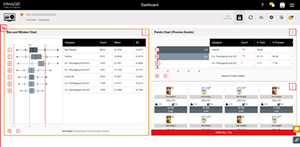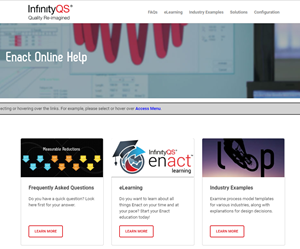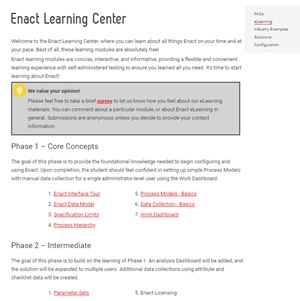The term “eLearning” first appeared in 1999. Over the ensuing years, it became known as “online learning” and “virtual learning.”
As you probably know, “eLearning” is currently defined as learning by using electronic technologies to access educational or training curriculum outside of a traditional classroom. In most cases, it refers to a course, program, certificate, or degree delivered completely online. For software companies, like InfinityQS, it’s an efficient, cost-effective way for users to learn and fill knowledge gaps with the software.
I’ve also come across the term “distance learning,” which has been around for a long time. In fact, way back in the 1840’s Isaac Pitman taught his pupils shorthand via correspondence. So, the idea of teaching people without actually being in the room with them has been around for quite some time.
eLearning is pretty common now (you might even call it a buzzword). As we moved into the 21
st century, businesses started adopting it.
And momentum for eLearning has been gathering. It’s become increasingly obvious that the cost savings incurred with the shift towards eLearning swing both ways: for students and for companies.

It’s a Global Thing
The thing that appeals most to me is that eLearning has the power to make learning your company’s software more accessible for users all around the world. It helps unite and train an increasingly global workforce. When learning materials are online, users are able to access content from anywhere and at any time.
InfinityQS has partners all around the globe, from the Far East to Africa to South America and, of course, the US. It’s unreasonable to expect a company in, say, Germany to be able to send a team of users to Fairfax, Virginia (our HQ location) for a week-long training session. Travel costs would be astronomical, there could be language issues, and the time away from other duties could be detrimental to the company.
eLearning brings the training to you…wherever you are.
Enact® Fits the Bill
InfinityQS’ Quality Intelligence Platform, Enact
®, is a great example of a software product that is perfectly suited to remote learning. While Enact is highly customizable, it is also a product for which we pre-define much of the work up front, lending it an “out-of-the-box” aspect that is very appropriate for eLearning. Allow me to explain.
It’s All About the Deployment
We have what we call the “ideal first 90 days” with Enact. The ideal deployment revolves around keeping your Enact experience simple, straightforward, and guaranteed to yield results in just a few weeks.
And because there is a set, recommended way in which to get your Enact experience rolling, we feel it is the perfect tool for eLearning. Here’s the first 90 days in a nutshell (it will be very clear why this software is right for remote learning when you see the plan):
- Start small – pick a specific production line, or family of products, that you know needs attention. Use the Enact process model—which illustrates how materials are transformed through operations to create an end product—and use manual data collection. Keep it simple.

- Get success – with your first process model and data collections in place, you and your managers will start seeing results immediately. Review the reports.

Make determinations about what needs to change. At 30 days or so, you can comfortably ascertain that you are collecting the right data. Show the data to upper management; they’ll see how this small usage of Enact paid for itself.
Then move on.
- Expand – use Enact with a similar process, either upstream or downstream. Re-use the process model on a similar line. The more you use Enact, the more it pays for itself.

For details about the first 90 days with Enact, please see the
Deployment blog by Eric Weisbrod, InfinityQS’ VP of Product Management. It’s an eye-opener.
Enact is Easy
You can see how structured and easy the first 90 days can be with Enact—if you keep it
simple. And remote learning fits right in with this.
A side benefit of keeping it simple while deploying Enact is that the more your operators use it, the more comfortable they’ll become with the interface and features. That way, when you reach the point where you expand the use of Enact, the scaling is easy and efficient. That’s Enact, easy and efficient.
How We Do It
We offer a host of eLearning modules, available right in our Help system. By the way, our Help system is probably the most robust help you’ve ever used. The context-sensitive system is currently available in English, German, and Spanish—this invaluable tool directs users to instructions, tips, videos, tutorials, best practices, getting started guides, FAQs, industry examples, and more.

And the Help system is always just a click away for users. But there’s so much more.
eLearning Available in Help
Enact’s eLearning (housed in what we call the Learning Center - see below) is available right on the Help system’s main page. It couldn’t be easier. This is a critical component of Enact’s “self-serve” strategy. We’re excited to offer our customers, channel partners, and service providers a free, easy, and convenient path to increasing their Enact knowledge, without incurring training costs.

It’s a 4-phased approach to building our eLearning library. And we’re well on our way. Phases 1-3 are available now; Phase 4 is due out soon. Each phase is typically made up of 7-9 topical modules, each of which take around five minutes to complete. We even include a short quiz after every module, so you can test your knowledge. The phases:
- Core Concepts – this phase includes everything you should need to implement a simple pilot project on a single line or machine
- Intermediate
- Advanced
- Enact Data Aggregation – A Closer Look
Enact Updates
Enact currently offers regular quarterly updates to the software system. These updates will sometimes introduce major user experience changes or new functionalities that warrant dedicated eLearning modules. And we’ll be providing them. It’s a growing, ever-more-robust system that will change according to our customers’ needs.
We’re happy to serve you and make Enact the best Quality Intelligence Platform available in the industry today.
eLearning is Here to Stay
eLearning isn’t just the wave of the future. It’s here now. And people want it. Users like to learn at their own pace (heck, they’re used to it by now), and enjoy the freedom to stop and then pick it up again whenever they like. They like that they can commit a good chunk of time to it when they can; and have the ability to take off small bites, too, whenever they can fit it into their busy schedules. And they like that they can participate from wherever they like—all you need is a browser!
Most of all, I think, is the feeling that customers get that they are wasting money with classroom training. Let’s face it, if you attend a classroom training and then don’t get a chance to use the tool (whatever it might be) right away,
and keep using it, then you can easily lose all the knowledge you gained in the classroom. That is frustrating.
We get that. And with Enact, you never have to worry about that. eLearning is at your fingertips…and it stays at your fingertips. So, enjoy the journey!
Here’s a list of some additional Enact reading that may interest you: